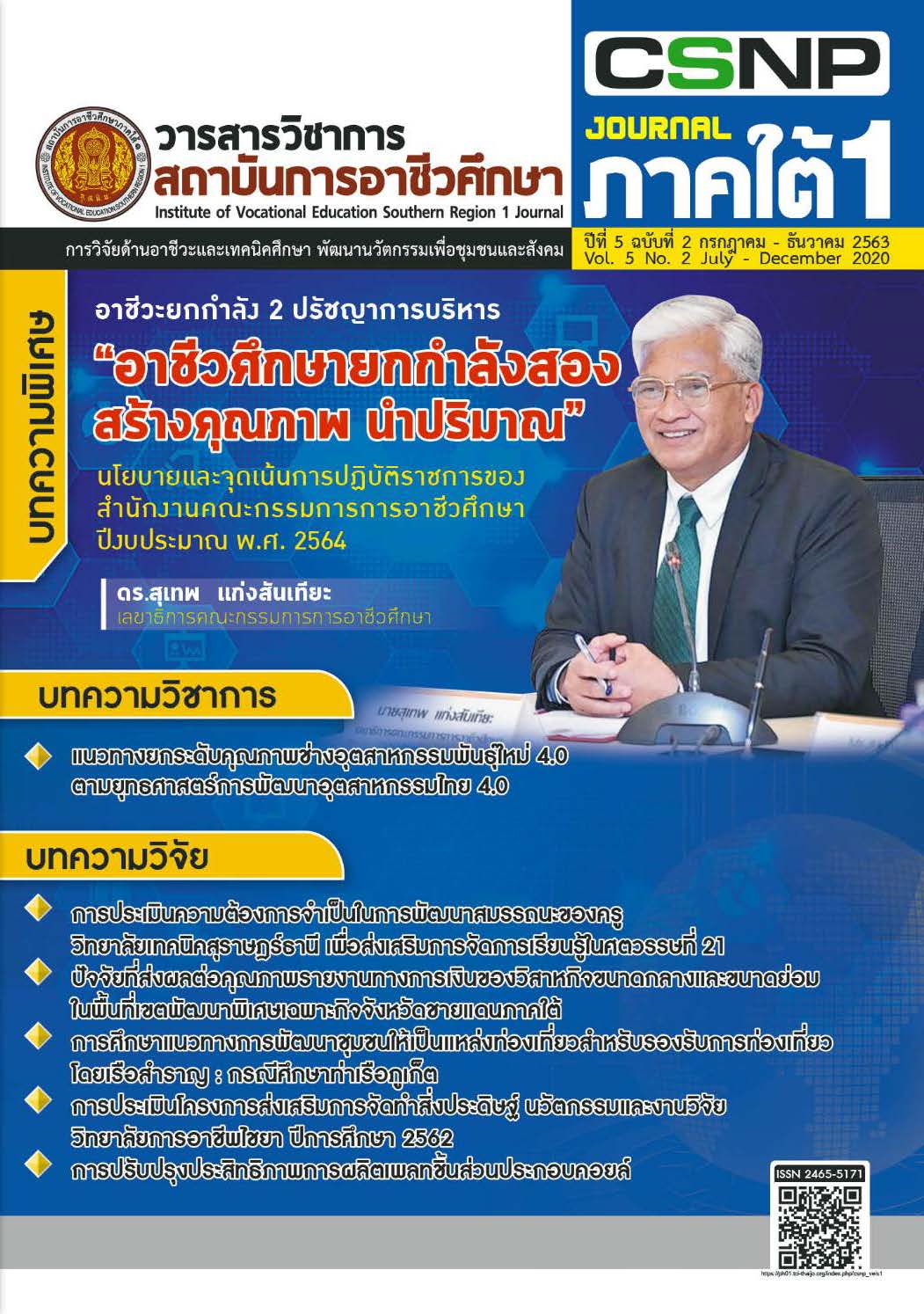Evaluation of Educational Management of Bachelor of Science in Technical Education Program in Mechatronics Engineering (5-year Program, Revised Version 2015) of Rajamangala University of Technology Srivijaya
Keywords:
Evaluation, Educational Management, Bachelor of Science in Technical EducationAbstract
The objectives of this research were: 1) to evaluate educational management of bachelor of Science in Technical Education Program in Mechatronics Engineering (5- year program revised version 2015) of Rajamangala University of Technology Srivijaya, 2) to compare the graduates' actual and expected competencies. The CIPP Model was used in this evaluation consisting of context, input, process and products. The instruments used in the study were three types of questionnaires, i.e. 1) checklist form, 2) rating scale form, and 3) open-ended form. The data were collected from 108 persons who were 6 teachers, 70 students, 24 graduates, and 8 graduate superiors from the Mechatronics Engineering Program. The collected data were analyzed by means of percentage, arithmetic mean, standard deviation, and t-test.
The results were as follows: 1) context evaluation, the objective, structure and course description of the curriculum were highly appropriate. 2) Input evaluation found that the teacher, student, classroom, teaching tools, media and material, and classroom activities were at the high level. 3) Process evaluation found that the process of curriculum administration, teaching and learning, and assessment were rated high. 4) Product evaluation based on the curriculum goals and the standard of professional knowledge, the graduates' competency was found at high level. Meanwhile, the comparison of the graduates' actual and expected competencies were different at the significant level of 0.05, in accordance with the research assumption that the expected graduates' competency was higher than the actual competency.
References
[2] ชวลิต ชูกำแพง. (2559). การวิจัยและพัฒนาหลักสูตร แนวคิดและกระบวนการ. กรุงเทพมหานคร : สำนักพิมพ์แห่งจุฬาลงกรณ์มหาวิทยาลัย.
[3] นิตยา เปลื้องนุช. (2555). การบริหารหลักสูตร (Curriculum Administration) (พิมพ์ครั้งที่ 2). ขอนแก่น : โรงพิมพ์มหาวิทยาลัยขอนแก่น.
[4] คณะครุศาสตร์อุตสาหกรรมและเทคโนโลยี มหาวิทยาลัยเทคโนโลยีราชมงคลศรีวิชัย. (2553). หลักสูตรครุศาสตร์อุตสาหกรรมบัณฑิต สาขาวิชาวิศวกรรมแมคคาทรอนิกส์ (5 ปี) (หลักสูตรใหม่ พ.ศ.2553). สงขลา : คณะครุศาสตร์อุตสาหกรรมและเทคโนโลยี.
[5] คณะครุศาสตร์อุตสาหกรรมและเทคโนโลยี มหาวิทยาลัยเทคโนโลยีราชมงคลศรีวิชัย. (2558). หลักสูตรครุศาสตร์อุตสาหกรรมบัณฑิต สาขาวิชาวิศวกรรมแมคคาทรอนิกส์ (5 ปี) (หลักสูตรปรับปรุง พ.ศ.2558). สงขลา : คณะครุศาสตร์อุตสาหกรรมและเทคโนโลยี.
[6] ปิยะนารถ จันทร์เล็ก, ภัคพงศ์ ปวงสุข, และอังคณา อ่อนธานี. (2561). การประเมินผลการจัดการศึกษาและติดตามผลหลักสูตรครุศาสตร์อุตสาหกรรมบัณฑิตสาขาวิชาครุศาสตร์เกษตร (ฉบับปรับปรุง พ.ศ. 2554) คณะ
ครุศาสตร์อุตสาหกรรมและเทคโนโลยี สถาบันเทคโนโลยีพระจอมเกล้าเจ้าคุณทหารลาดกระบัง. วารสารศึกษาศาสตร์. ปีที่ 29 ฉบับที่ 3. 190-203.
[7] รัตนะ บัวสนธ. (2556). รูปแบบการประเมิน CIPP และ CIPPIEST มโนทัศน์ที่คลาดเคลื่อนและถูกต้องในการใช้. วารสารศิลปากรศึกษาศาสตร์วิจัย. ปีที่ 5 ฉบับที่ 2. 2-9.
[8] ไชยยันต์ ถาวระวรณ์, เมธี ธรรมวัฒนา, และมานพ แจ่มกระจ่าง. (2559). การประเมินผลหลักสูตร สาขาวิชาเทคโนโลยีอุตสาหกรรมศึกษา ภาควิชาการอาชีวศึกษาและพัฒนาสังคม คณะศึกษาศาสตร์ โดยประยุกต์ใช้รูปแบบการประเมินตามแบบจำลองซิปป์. วารสารการศึกษาและการพัฒนาสังคม. ปีที่ 12 ฉบับที่ 1. 212-223.
[9] สุวิมล ติรกานันท์. (2551). การสร้างเครื่องมือวัดตัวแปรในการวิจัยทางสังคมศาสตร์: แนวทางสู่การปฏิบัติ (พิมพ์ครั้งที่ 2). กรุงเทพมหานคร : ศูนย์หนังสือแห่งจุฬาลงกรณ์มหาวิทยาลัย.
[10] บุญชม ศรีสะอาด. (2546). การพัฒนาหลักสูตรและการวิจัยเกี่ยวกับหลักสูตร. กรุงเทพมหานคร : สุวีริยาสาสน์การพิมพ์.
[11] วิเชียร เกตุสิงห์. (2538). ค่าเฉลี่ยกับการแปลความหมาย : เรื่องง่าย ๆ ที่บางครั้งก็ผิดพลาดได้. ข่าวสารวิจัยการศึกษา. ปีที่ 18 ฉบับที่ 3. 8-11.
[12] ทิศนา แขมมณี. (2551). ศาสตร์การสอน. พิมพ์ครั้งที่ 8. กรุงเทพมหานคร : ด่านสุทธาการพิมพ์.
[13] ราชกิจจานุเบกษา. (2556). ข้อบังคับคุรุสภา. มาตรฐานวิชาชีพ พ.ศ. 2556. เล่ม 130 ตอนพิเศษ
130 ง : 65-71.



